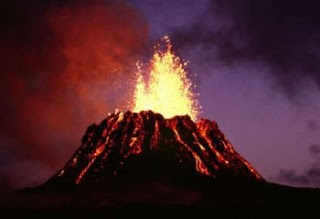Ohio State University researchers have found a new way to gauge the depth of the magma chamber that forms the Hawaiian Island volcanic chain, and determined that the magma lies much closer to the surface than previously thought.
The finding could help scientists predict when Hawaiian volcanoes are going to erupt. It also suggests that Hawaii holds great potential for thermal energy.
Julie Ditkof, an honors undergraduate student in earth sciences at Ohio State, described the study at the American Geophysical Union Meeting in San Francisco on Tuesday, December 14.
For her honors thesis, Ditkof took a technique that her advisor Michael Barton, professor of earth sciences, developed to study magma in Iceland, and applied it to Hawaii.
She discovered that magma lies an average of 3 to 4 kilometers (about 1.9 to 2.5 miles) beneath the surface of Hawaii.
“Hawaii was already unique among volcanic systems, because it has such an extensive plumbing system, and the magma that erupts has a unique and variable chemical composition,” Ditkof explained. “Now we know the chamber is at a shallow depth not seen anywhere else in the world.”
For example, Barton determined that magma chambers beneath Iceland lie at an average depth of 20 kilometers.
While that means the crust beneath Hawaii is much thinner than the crust beneath Iceland, Hawaiians have nothing to fear.
“The crust in Hawaii has been solidifying from eruptions for more than 300,000 years now. The crust doesn’t get consumed by the magma chamber. It floats on top,” Ditkof explained.
The results could help settle two scientific debates, however.
Researchers have wondered whether more than one magma chamber was responsible for the varying chemical compositions, even though seismological studies indicated only one chamber was present.
Meanwhile, those same seismological studies pegged the depth as shallow, while petrologic studies – studies of rock composition – pegged it deeper.
There has never been a way to prove who was right, until now.
“We suspected that the depth was actually shallow, but we wanted to confirm or deny all those other studies with hard data,” Barton said.
He and Ditkof determined that there is one large magma chamber just beneath the entire island chain that feeds the Hawaiian volcanoes through many different conduits.
They came to this conclusion after Ditkof analyzed the chemical composition of nearly 1,000 magma samples. From the ratio of some elements to others – aluminum to calcium, for example, or calcium to magnesium – she was able to calculate the pressure at which the magma had crystallized.
For his studies of Iceland, Barton created a methodology for converting those pressure calculations to depth. When Ditkof applied that methodology, she obtained an average depth of 3 to 4 kilometers.
Researchers could use this technique to regularly monitor pressures inside the chamber and make more precise estimates of when eruptions are going to occur.
Barton said that, ultimately, the finding might be more important in terms of energy.
“Hawaii has huge geothermal resources that haven’t been tapped fully,” he said, and quickly added that scientists would have to determine whether tapping that energy was practical – or safe.
“You’d have to drill some test bore holes. That’s dangerous on an active volcano, because then the lava could flow down and wipe out your drilling rig.”
Note: This story has been adapted from a news release issued by the Ohio State University











